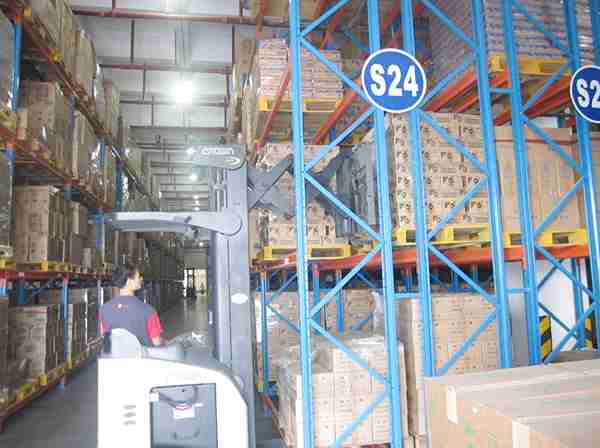📐 "First 50 Enterprise Queries Get Custom 3D Warehouse Design" Plan

Introduction: Revolutionizing Warehouse Storage with Double-Deep Racking
In an era where warehouse space is at a premium, double-deep racking systems have emerged as a game-changing storage solution. These innovative systems allow businesses to store pallets two-deep, effectively doubling storage capacity without expanding their facility’s footprint. Unlike traditional selective racking, double-deep racking systems minimize wasted aisle space, making them ideal for warehouses that need to maximize storage density while minimizing costs.
This in-depth guide explores every aspect of double-deep racking systems, from their structural advantages to real-world applications in various industries. By the end, warehouse managers, logistics professionals, and supply chain experts will understand why double-deep racking is becoming the go-to choice for high-efficiency storage solutions.

H1: What Are Double-Deep Racking Systems?
H2: The Science Behind Double-Deep Storage
Double-deep racking systems are engineered to store pallets in a two-deep configuration, meaning two rows of pallets sit back-to-back within the same bay. Unlike selective racking, which allows direct access to every pallet, double-deep racking systems require a specialized forklift with extended reach capabilities to retrieve the second pallet.
This design eliminates unnecessary aisles, increasing storage capacity by up to 50% compared to single-deep setups. While double-deep racking systems follow a Last-In, First-Out (LIFO) inventory system, their superior space utilization makes them a preferred choice for facilities with high-volume, slow-moving inventory.
H2: Key Components of Double-Deep Racking Systems
A well-designed double-deep racking system consists of:
-
Heavy-duty upright frames – Reinforced to support double the load.
-
Deep-reach beams – Extended to accommodate two pallets.
-
Forklift-compatible spacing – Ensures smooth pallet retrieval.
-
Safety guards & load stops – Prevents accidental pallet dislodgment.
H1: Why Double-Deep Racking Systems Outperform Traditional Storage
H2: 1. Unmatched Storage Density
The primary advantage of double-deep racking systems is their ability to store more pallets in the same square footage. By reducing aisle space, warehouses can increase storage capacity by 40-50%, making these systems ideal for facilities with limited expansion options.
H2: 2. Significant Cost Savings
-
Lower real estate costs – Fewer aisles mean a smaller warehouse footprint.
-
Reduced construction expenses – No need for additional building expansions.
-
Decreased energy costs – Smaller space requires less HVAC and lighting.
H2: 3. Enhanced Operational Efficiency
-
Faster pallet retrieval compared to drive-in racking.
-
Better space utilization than selective racking.
-
Seamless integration with WMS (Warehouse Management Systems).
H2: 4. A Smarter Alternative to Automation
For warehouses not yet ready to invest in fully automated storage systems (AS/RS), double-deep racking systems offer a high-density, semi-automated solution at a fraction of the cost.
H1: Where Double-Deep Racking Systems Excel
H2: Cold Storage & Refrigerated Warehouses
In cold storage facilities, where space is expensive, double-deep racking systems help minimize refrigerated square footage while maximizing storage.
H2: Retail & E-Commerce Distribution Centers
For businesses managing high-volume SKUs, double-deep racking systems provide an efficient way to store bulk inventory without sacrificing accessibility.
H2: Manufacturing & Industrial Warehousing
Factories storing raw materials or bulk components benefit from the high-density storage that double-deep racking systems provide.
H1: Double-Deep Racking vs. Other Storage Systems
H2: Double-Deep vs. Selective Racking
| Feature | Double-Deep Racking | Selective Racking |
|---|---|---|
| Storage Density | 40-50% higher | Standard |
| Accessibility | LIFO (Last-In, First-Out) | Direct (FIFO or LIFO) |
| Forklift Requirements | Deep-reach forklifts | Standard reach trucks |
H2: Double-Deep vs. Drive-In Racking
-
Drive-in racking allows deeper storage but lacks selectivity.
-
Double-deep racking systems offer a balanced approach, providing better accessibility than drive-in while still maximizing density.
H1: Best Practices for Implementing Double-Deep Racking Systems
H2: 1. Choose the Right Forklift Equipment
Since double-deep racking systems require extended-reach forklifts, warehouses must ensure their fleet includes trucks with at least 18’ fork extensions.
H2: 2. Optimize Inventory Slotting for LIFO Efficiency
-
Fast-moving SKUs should be placed in front positions for quicker access.
-
Slow-moving inventory can be stored in the rear positions.
H2: 3. Conduct a Structural Floor Evaluation
Because double-deep racking systems concentrate weight differently than selective racking, a professional floor load analysis is essential before installation.
H1: Addressing Common Challenges with Double-Deep Racking
H2: 1. Limited Selectivity (LIFO Restriction)
Solution: Use a hybrid storage approach, combining double-deep racking with selective racking for high-turnover items.
H2: 2. Higher Forklift Operator Skill Requirements
Solution: Invest in specialized forklift training programs to ensure smooth operations.
H1: The Future of Double-Deep Racking Systems
-
Integration with warehouse robotics for automated pallet retrieval.
-
AI-driven slotting optimization to maximize storage efficiency.
-
Enhanced safety sensors to prevent accidental pallet damage.
Conclusion: Why Double-Deep Racking Systems Are the Future of Warehousing
Double-deep racking systems represent the perfect balance of storage density, cost efficiency, and operational flexibility. By reducing wasted aisle space and maximizing vertical storage, these systems allow warehouses to store more inventory without expanding their footprint.
For businesses looking to optimize warehouse space, reduce operational costs, and improve inventory management, double-deep racking systems offer an unbeatable solution.
FAQs: Answering Key Questions About Double-Deep Racking
1. Can double-deep racking systems be used in very narrow aisle (VNA) warehouses?
Yes, but they require specialized VNA forklifts with extended reach capabilities.
2. What is the maximum height for double-deep racking systems?
Most double-deep racking systems support heights of up to 40 feet, depending on forklift reach.
3. Are double-deep racking systems suitable for perishable goods?
Absolutely, especially in cold storage, but LIFO management must be carefully planned.
4. How much weight can double-deep racking systems support?
Standard systems handle 2,000–5,000 lbs per pallet position, with heavy-duty options available.
5. Can existing selective racking be converted to double-deep racking?
In some cases, yes, but structural reinforcements may be necessary.
By implementing double-deep racking systems, warehouses can dramatically improve storage efficiency while keeping costs under control.




